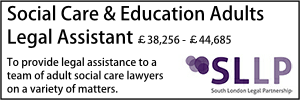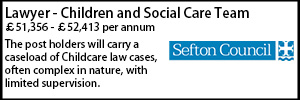Family President signals need for “radical departure” from current model of how courts consider contact with birth family after adoption
- Details
The President of the Family Division, Sir Andrew McFarlane, has outlined a “pressing need” for courts and those who advise them to modernise the approach that is taken to supporting young, adopted persons by “enhancing the degree to which they may maintain some form of relationship with their birth family after adoption”.
In a speech to Plymouth Law Society earlier this month (9 November), Adapting Adoption to the Modern World (read in full here), the Family President highlighted a recently published report by the Public Law Working Group (PLWG) Adoption Sub-Group, which recommended a “greater focus” on the issue of contact with birth families, and for adopted adults to have more straightforward access to their records.
Sir Andrew noted that following the end of the days of ‘forced adoption’ or ‘relinquished babies’ through reforming legislation in the 1970’s, adoption is now principally used for children who have been protected from child abuse by removing them from the care of their natural family.
He said: “Such children are likely to require continued protection in the years to come, but, one may ask, how bad must the home circumstances be to justify not merely keeping the child safe during childhood, but legally removing her from her family forever and grafting her permanently into another family for the remainder of her life.
“The answer to that question, established by a decision of the UK Supreme Court , is that adoption will only be the proportionate remedy when it is necessary to meet the child’s welfare needs throughout their life and ‘nothing else’ (meaning no less intrusive arrangement) ‘will do’. The court must look at the realistic options for the child’s future care and must, in particular, consider the relationship that she has with any person and the impact of ceasing to be a member of the birth family and becoming an adopted person.”
The Family President noted that “in a world where communication was confined to letters and landline telephones, and a photograph was always a physical thing, it was possible, indeed easy, to maintain an adopted child in an hermetically sealed environment of this nature into adulthood unless the adopted person actively sought to trace their original family.
“Should they wish to do so, the process of giving them the identifying information was, for their own benefit, carefully controlled and supported by trained post-adoption counsellors.”
He highlighted how, with the explosion of digital communication in the past two decades it is possible for an adopted child, “quietly, alone in their bedroom, without the knowledge of their adopted parents”, to trace and find their family.
“The temptation to do so, and then to make contact with them, must be almost irresistible. But the dangers of doing so, and the potential for significant emotional harm to result, are easy to contemplate. Unlike the babies taken at birth of yesteryear, today’s adoptees have normally been removed from their family because they have experienced, or were likely to experience, significant harm there; harm of a nature and degree that justified permanent life-long placement as part of another family.”
Sir Andrew continued: “It is, sadly, now a not uncommon experience, despite the best efforts of adopters who have made a full, lifelong and loving commitment to their child, to experience the breakdown of that relationship during the teenage years with, in some cases, the young person moving with their feet and trying to rejoin their birth family. Such attempts often fail, or are a cause of further harm to the child. Fresh child protection procedures may be commenced between local authority social services with the adopters, as the child’s parents.”
The Family President said the central question from his perspective was to ask whether the law, and the manner in which it is currently applied by the courts, continues to be fit for purpose, or whether it requires adapting to meet the changing needs of adopted children in the modern world.
He suggested that the term ‘contact’ was itself unhelpful in this context. “To lawyers, and no doubt to birth parents, it is likely to mean direct communication, and/or meetings, with the child.”
Sir Andrew warned, however, that “such a narrow, or functional, view is unhelpful as it can obscure one of the core features of adoption, namely the severing of the child’s relationship with their birth parents and the establishment of a new set of relationships with the adopters.
“The consequences of the breaking and making of relationships is significant for all those involved including a profound sense of loss for the birth parents, a sense of confusion for the child/adolescent/adult and a source of anxiety for the adoptive parents. Any attempt to re-build these relationships in a meaningful and safe way through contact must take into account the needs of the individuals in a more comprehensive way than that provided by annual ‘letterbox’ messages.”
In his speech the judge set out a range of factors that would likely be relevant in most cases when developing a bespoke plan for contact for an individual adopted child.
Sir Andrew continued: “I am not alone in considering letter-box contact to be outdated and no longer apt to meet the more sophisticated understanding that now exists of a young adopted person’s needs.”
‘Letter-box’ contact typically involves the adopters and the natural parents communicating with each other by a short letter or report once each year.
Sir Andrew noted that a “deficit” of letter-box communication is that it is typically only sent to the birth mother, and rarely to the father or any siblings who may be separated from the adopted child.
“In addition, the model would seem to be based upon a fear of contact with the natural family destabilising the adoptive placement, when more modern thinking indicates that maintaining some continuing relationship with the natural family can assist the child,” he said.
The Family President said it was clear to him that a bespoke plan for future contact between a child and their birth family should be developed at an early stage and well before that child moves on to be placed for adoption.
He noted the PLWG Adoption Sub-Group’s recommendation that there needs to be a greater focus on the issue of contact with the birth family “as long as it is safe”.
The sub-group also suggested a change in social work practice and training for all involved in the process (including prospective adopters) to give “more focus to contact and the benefits that it can bring for many (although not all) adopted children”.
Making his own comments on the issue of contact, Sir Andrew said: “Currently, in many cases, when the court makes a placement for adoption order consideration of contact may be confined to the immediate cessation of the current arrangements, with little or no thought being given to the medium and long-term support that can be given to the child prior to, during and after placement for adoption. My own view is that there is a need for a radical departure from that model.
“It should be the responsibility of the court, at this key stage when it has determined that a child is to be adopted, but before the adoptive placement has been identified, to establish the basis and structure for any continuing relationship with the birth family. This may require looking beyond the birth parents to other members of the child’s wider family to see if there is someone, for example an aunt or a cousin, with whom the child may have an intermittent, safe, but real, relationship down the years.”
Another key recommendation of the PLWG sub-group was that the full range of contact options (including digital options) should be “actively considered” by professionals and the court during care and placement proceedings rather than being dealt with by an assumption that contact will be via letterbox only.
The sub-group went on to recommend that courts should consider how they can use the jurisdiction to make contact orders under s 26 of ACA 2002 to set out clearly the assessed needs of the child to stay in touch with relevant members of their birth beyond the point of the placement order (where prospective adopters may or may not yet be identified), particularly in cases where it would be detrimental for the child to have contact cut off at this stage.
“Any such orders end when the adoption order is made, but they may set the tone for what the court determines should happen after the adoption order,” Sir Andrew said.
The Family President did not agree that this might hinder the task of finding prospective adopters or compromise the autonomy they are afforded. “The court’s focus is solely on the best interests of the child, not on those of potential future adopters.”
He added: “Where, for the reasons that I have attempted to set out in this lecture, the court considers that there should be continuing contact up to and after adoption it should establish this by a court order at the time of making a placement order. The contact regime will be reviewed at any subsequent adoption hearing at which the adopters can be heard.”
The sub-group recommended that at that later stage, courts should consider, in the right case, the use of section 51A ACA 2002 which contemplates the making of a contact order now or at any time after the making of an adoption order. “In some cases, that provision may be used to facilitate a review of contact by the court at a suitable time after the making of the adoption order, for example where direct contact is not appropriate at the time of the order but may be indicated at a time in the foreseeable future.”
Sir Andrew said the sub-group recognised that imposing an order on unwilling adopters was a very serious matter, but they considered that, if the other recommendations in their report were accepted, there was hope that, with greater support and training for all concerned, decisions about contact were overwhelmingly likely to be made by consent. “In this regard, they also recommend that consideration should be given in every case to a meeting between the adopters and members of the birth family.”
The sub-group also recommended that after the adoption order is made, periodic reviews of contact plans should be offered by the adoption social worker to ensure the plan is still meeting the child’s needs and to consider any changes to the contact or support for contact that might be needed.
The recommendations of the PLWG Adoption sub-group are out for consultation until 30 November.
The Family President noted that following this, the group will submit its final report and he will “indicate whether or not any final recommendations are accepted and are to be followed”.
Lottie Winson





















































